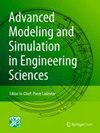用学习到的代理和约束求解基于多物理场的逆问题
IF 3.2
Q3 MECHANICS
Advanced Modeling and Simulation in Engineering Sciences
Pub Date : 2023-10-11
DOI:10.1186/s40323-023-00252-0
引用次数: 3
摘要
当多模态时移数据采集成本高、数值模拟成本高时,求解地质碳储量监测中基于多物理场的逆问题具有挑战性。我们通过结合计算成本低廉的学习代理和学习约束来克服这些挑战。这种组合不仅大大提高了对重要流体流动特性、渗透率的反演,而且还为包括井测量和有源时移地震数据在内的多模态数据的反演提供了一个天然的平台。通过添加学习约束,我们得到了一种计算上可行且保持准确的反演方法。这是通过包含一个经过训练的深度神经网络(称为归一化流)来实现的,该网络迫使模型迭代保持在分布中,从而保证了训练的傅立叶神经算子的准确性,这些算子作为计算成本高昂的多相流模拟的替代品,涉及偏微分方程的求解。通过精心挑选的实验,围绕地质碳储量问题,我们证明了所提出的约束优化方法在两种不同的数据模式下的有效性,即时移井和时移地震数据。虽然这两种方法的渗透率反演各有利弊,但它们的联合反演均受益于任何一种方法,无论是在监测井附近还是在远离监测井的地方,都能获得有价值的优越渗透率反演和CO 2羽流预测。本文章由计算机程序翻译,如有差异,请以英文原文为准。
Solving multiphysics-based inverse problems with learned surrogates and constraints
Abstract Solving multiphysics-based inverse problems for geological carbon storage monitoring can be challenging when multimodal time-lapse data are expensive to collect and costly to simulate numerically. We overcome these challenges by combining computationally cheap learned surrogates with learned constraints. Not only does this combination lead to vastly improved inversions for the important fluid-flow property, permeability, it also provides a natural platform for inverting multimodal data including well measurements and active-source time-lapse seismic data. By adding a learned constraint, we arrive at a computationally feasible inversion approach that remains accurate. This is accomplished by including a trained deep neural network, known as a normalizing flow, which forces the model iterates to remain in-distribution, thereby safeguarding the accuracy of trained Fourier neural operators that act as surrogates for the computationally expensive multiphase flow simulations involving partial differential equation solves. By means of carefully selected experiments, centered around the problem of geological carbon storage, we demonstrate the efficacy of the proposed constrained optimization method on two different data modalities, namely time-lapse well and time-lapse seismic data. While permeability inversions from both these two modalities have their pluses and minuses, their joint inversion benefits from either, yielding valuable superior permeability inversions and CO 2 plume predictions near, and far away, from the monitoring wells.
求助全文
通过发布文献求助,成功后即可免费获取论文全文。
去求助
来源期刊

Advanced Modeling and Simulation in Engineering Sciences
Engineering-Engineering (miscellaneous)
CiteScore
6.80
自引率
0.00%
发文量
22
审稿时长
30 weeks
期刊介绍:
The research topics addressed by Advanced Modeling and Simulation in Engineering Sciences (AMSES) cover the vast domain of the advanced modeling and simulation of materials, processes and structures governed by the laws of mechanics. The emphasis is on advanced and innovative modeling approaches and numerical strategies. The main objective is to describe the actual physics of large mechanical systems with complicated geometries as accurately as possible using complex, highly nonlinear and coupled multiphysics and multiscale models, and then to carry out simulations with these complex models as rapidly as possible. In other words, this research revolves around efficient numerical modeling along with model verification and validation. Therefore, the corresponding papers deal with advanced modeling and simulation, efficient optimization, inverse analysis, data-driven computation and simulation-based control. These challenging issues require multidisciplinary efforts – particularly in modeling, numerical analysis and computer science – which are treated in this journal.
 求助内容:
求助内容: 应助结果提醒方式:
应助结果提醒方式:


